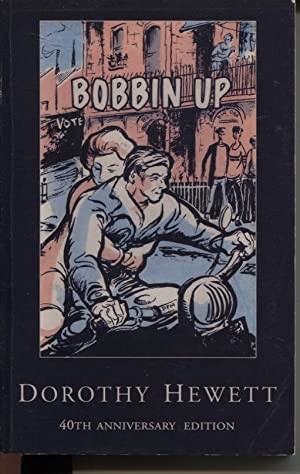Forty years after its first publicaton and several European translations Bobbin Up, a classic of industrial fiction, is coming home. This document of urban working-class life in 1950s Australia is also a remarkably well crafted novel, combining the shifting narrative viewpoint pioneered by Modernism with a relentless realist mode. Well before the upsurge of feminism Dorothy Hewetthomed in on embattled female lives. The book abounds with portraits of working women, married and unmarried, middle-aged and young, zestful and tired. These varied existences form the collective hero(ine) of a novel whose social message has lost nothingof its urgency. Unemployment, experienced or dreaded, haunts people’s lives now as then. At the end of the twentieth century the appalling working and living conditions of the poor described here in graphic detail still obtain, not only in the Third World but also in the sweatshops and depressed areas of the First
Four young Australian factory workers, Shirl, Dawnie, Patty, and Nell, a Communist Party member, band together to face their problems.
Dorothy Hewett was a left-wing Australian journalist in the 1950s. She originally wrote Chapter 15 of Bobbin Up as a short story, and in 1958 added fourteen chapters to develop a rich set of characters, and followed Chapter 15 with a single chapter of denouement. The result is a moving portrayal of women working in Australia’s woolen mills, enduring long hours and poor conditions in the struggle to support their families. Many of these women were very young — teenagers, mostly — and living in poverty, but dreaming of a better standard of living.
Hewett modelled Bobbin Up and its characters on her own experience. Hewett arrived in Sidney in 1949 and became involved in the Communist Party. She asked for a job in the worst factory in Sydney,” and was put to work in the Alexandria Spinning Mills. She spent a year there…
Dorothy Hewett was born on May 21, 1923 in Perth, Australia. She was an Australian feminist poet, novelist, and playwright. She was brought up on a sheep farm in Western Australia. In 1944 Hewett began studying English at the University of Western Australia (UWA). It was here that she joined the Communist Party in 1946. Also during her time at UWA she won a major drama competition and a national poetry competition. Hewett published her first novel, Bobbin Up, in 1959. The novel is regarded as an example of social realism. In 1967 Hewett’s increasing disillusionment with Communist politics was evidenced by her collection Hidden Journey. In 1973 Hewett was awarded one of the first fellowships by the Australia Council. The organisation granted her several fellowships, and later awarded her a lifetime emeritus fellowship. During her life she wrote 15 plays, the most famous of which are: This Old Man Comes Rolling Home (1967), The Chapel Perilous (1972), and The Golden Oldies (1981). Several plays, such as The Man From Mukinupin (1979), were written in collaboration with Australian composer Jim Cotter. In 1975, she published a controversial collection of poems, Rapunzel in Suburbia. Virago Press. published the first volume of her autobiography, Wild Card, in 1990. The book dealt with her lifelong quest for sexual freedom and the negative responses she received. Two years later she published her second novel, The Toucher. In 1990 a painting of Hewett by artist Geoffrey Proud won the Archibald Prize, Australia’s most prominent portrait prize. Dorothy Hewett passed away on August 25, 2002.
- xviii, 233 pages ; 20 cm. #240924R
- Hewett, Dorothy, 1923-2002
